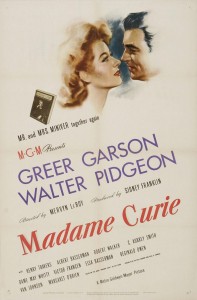Greer Garson, MGM’s leading actress of the 1940s, plays the titular role in Madame Curie, a loosely fact-based biopic of the famous French scientists.

The movie was one of the studio’s prestige productions, which became popular with the public and the Oscar voters, solidifying the status of Garson as a reliable leading lady.
Marie begins as a Polish student in Paris at the turn of the century (circa 1890), sharing a lab with the scientist Pierre Curie (Walter Pidgeon). The shy professor grows to like and respect her and the two get married. Jointly, they begin to observe the odd behavior of certain samples of pitchblende. Zealous devotion and methodical research for at least five years of study lead to Marie’s discovery of radium.
Years pass by and the Curies persevere, struggling to find financial backing for their research until they finally extract one decigram of radium from thousands of pounds of pitchblende. The scientific breakthrough makes the couple famous, but then personal tragedy strikes.
Throughout it all, struggling with the authorities, the scientific establishment, and other seemingly insurmountable obstacles, Madame Curie maintains her dignity, nobility, and willful grace, which were the specialty of Garson as an actress.
Paul Osborn and Paul A. Rameau’s intelligent screenplay is adapted from Eve Curie’s biography of her mother. Mervyn Leroy’s direction is functional, and he finds the right balance popularizing details of scientific research for the mass audience to understand and offering more intimate chapters of the marriage and family lives.
This was the third and most successful teaming to date of Garson and Pidgeon, after “Mrs. Miniver” and “Blossoms in the Dust.” The actors convey the scientists’ collaborative union as a warm and rewarding relationship, and even make the pursuit for knowledge a romantic and thrilling endeavor.
That said, you can’t ignore the fact that this was a prestige production, with top-notch talent and production values, designed to get critical recognition and Oscars. As a biopic about real-life famous scientists, “Madame Curie” is a perfect Oscar-stuff movie.
Oscar Nominations: 7
Picture, produced by Sidney Franklin
Actor: Walter Pidgeon
Actress: Greer Garson
Interior Decoration (b/w): Cedric Gibbons and Paul Groesse, art direction; Edwin B. Willis and Hugh Hunt, set decoration
Cinematography (b/w): Joseph Ruttenberg
Score: Herbert Stothart
Sound Recording: Douglas Shearer
Oscar Awards: None
Oscar Context
This was the last year, in which ten films were nominated for Best Picture. In 1944, the top category was standardized to include five nominees (as in most categories).
In 1943, “Madame Curie” competed for the Best Picture Oscar with “Casablanca” (which won), “For Whom the Bell Tolls,” “Heaven Can Wait,” “The Human Comedy,” “In Which We Serve,” “The More the Merrier,” “The Ox-Bow Incident,” “The Song of Bernadette,” and “Watch on the Rhine.”
The most nominated films were “The Song of Bernadette” (10), followed by “For Whom the Bell Tolls” (9). Though at the top of his form, Bogart lost the Oscar to Paul Lukas for “Watch on the Rhine,” which won the Best Picture from the New York Film Critics Circle. Bogart’s co-star, Ingrid Bergman was nominated for Best Actress in Paramount’s “For Whom the Bell Tolls.”
Jennifer Jones won Best Actress for “The Song of Bernadette,” which also won b/w Cinematography Oscar for Arthur Miller, b/w Interior Decoration, and Scoring, by Alfred Newman. The Sound award went to Stephen Dunn for “This Land Is Mine.”
Cast
Madame Marie Curie (Greer Garson)
Pierre Curie (Walter Pidgeon)
David LeGros (Robert Walker)
Madame Eugene Curie (Dame May Whitty)
Eugene Curie (Henry Travers)
Lord Kelvin (C. Aubrey Smith)
Prof. Jean Perot (Albert Basserman)
President of the University (Victor Francen)
Dr. Henri Becquerel (Reginald Owen)
Reporter (Van Johnson)
Other Credits
Costumes: Irene Sharaff, Gile Steele
F/X: Warren Newcombe
Black-and-white
Running Time: 124 Minutes










